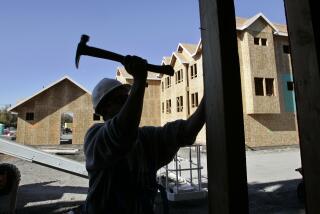A free-market fix to the nation’s housing hangover
There’s a reason California hasn’t seen as much of an economic recovery as some states: It has a serious debt problem.
The nation’s mortgage hangover is particularly bad in the Golden State. From 2000 to mid-2006, home prices across the nation doubled, outpacing inflation six times. In the Los Angeles area, things were much more extreme: Home prices nearly tripled. Prices in San Diego and San Francisco beat the nation too. And even though home prices have now plummeted, much of the debt that funded the bubble remains and is still hampering the economy.
The crisis has not affected all states equally. Some parts of the country have a lot of homeowners who owe more than their houses are worth, but they also had far lower home prices at the height of the bubble, so the amount each borrower owes is relatively low. In other places, such as New York, fewer homeowners are “underwater.” But because housing costs are high, these homeowners each owe a lot.
California ranks in the top five of both categories. Nearly a third of California homeowners with mortgages — 2.1 million families — owe more than their homes are worth, according to CoreLogic. And each of those borrowers is underwater by an average of about $93,000.
This all adds up to $196 billion in dead-weight debt in California that isn’t backed by property value. If home prices were to fall by an additional 5% — not an unlikely scenario — that figure would rise to $225 billion.
To put the numbers in perspective: $200 billion is more than twice the $79 billion in general obligation bond debt that Californians owe. State bonds, though, generally pay for something useful, like road repairs. Dead mortgage debt doesn’t pay for anything but a forehead-slapping “what were we thinking?”
It would cost California’s underwater homeowners more than $12 billion annually over 30 years to pay off this debt, even at today’s super-low interest rates. That’s money that people can’t save for retirement or their kids’ education, or can’t put into businesses to create jobs.
No magic wand can make all this debt go away, nor should it. Some people have good reasons for paying debt on bubble-era valuations. They like their houses, or they think it would be a moral failing to leave. Maybe they figure house prices will regain bubble-era heights in less time than it would take to repair credit scores after defaulting.
For people who aren’t sure, though, it’s past time for Washington to stop prolonging the suffering that comes with uncertainty. How? By letting the free market work.
Washington has attempted to intervene since the start of the crisis, but the interventions have only prolonged the pain. And elected officials have been reluctant to do the one thing that would make a difference: forcing lenders to accept responsibility for their bad lending practices.
Take the 2009 home buyer tax credit, which dangled an $8,000 credit to first-time home buyers. The bust had just exposed the consequences of reckless borrowing, so what did Washington do? It encouraged more people to take on debt to buy homes that were still overvalued, and encouraged the banks to fund that indebtedness.
And let’s look at the Federal Reserve Board’s actions. By keeping interest rates at close to zero percent since 2008, the Fed has allowed banks to borrow nearly for free. All that cheap money has kept banks from having to cut their losses by either seizing and selling off properties that are underwater or reducing loan amounts so that people can stay in their homes. Instead, they have strung out their bad loans. But that can’t go on forever.
Another Washington program, the Home Affordable Modification Program, was supposed to encourage banks to modify loans for underwater homeowners. But the modifications that lenders offered seldom addressed the problem. Many offers involved extending teaser interest rates, or tacking on defaulted amounts to the end of a mortgage’s life. Washington has not used its leverage to push lenders to write down the amount owed. Instead, the biggest beneficiaries of Washington’s modification program have been mortgage “servicers,” the folks who handle paperwork for lenders to modify loans.
To see how bizarre the government’s strategy is, consider this: Recently, federal regulators exacted a $108-million settlement from Countrywide, once the nation’s largest mortgage lender. The money is because Countrywide, now owned by Bank of America, has behaved incompetently, at best, in servicing defaulted mortgages.
Yet over the last year, through the Home Affordable Modification Program, federal taxpayers have spent nearly $132 million in “incentive payments” to Countrywide and its investors and borrowers to reward the company for its superficial mortgage adjustments.
The Federal Housing Administration too has done its part to keep the bubble inflated, nearly doubling the size of mortgages eligible for a government-insured lending program, to $729,750, up from $417,000, starting in the fall of 2008. People can put as little as 3.5% down for such loans, meaning that a slim decrease in house prices traps them underwater too.
It’s time to end these market-distorting charades. If President Obama won’t say so, one of his White House rivals should seize the moment.
House prices need to find their lows. That would give buyers confidence to jump back in at prices they could afford without sacrificing their futures to debt. To help prices find their new normal, banks need to modify loans by reducing the amount owed. When that doesn’t make sense, banks should foreclose on delinquent owners promptly and legally. The current high number of bad loans in limbo guarantees economic chaos.
Nicole Gelinas is a contributing editor to the Manhattan Institute’s City Journal.
More to Read
A cure for the common opinion
Get thought-provoking perspectives with our weekly newsletter.
You may occasionally receive promotional content from the Los Angeles Times.










